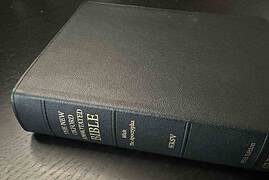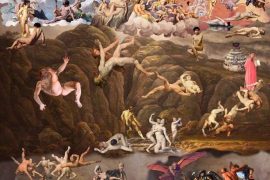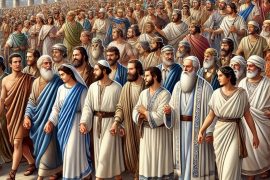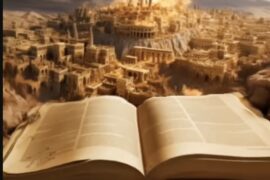My book, The Jesus Dynasty was published in April 2006 (Simon & Schuster). It was a New York Times Best Seller for several weeks, featured on ABC’s Nightline and 20/20, and made the covers of USNews & World Report in the US and Profil magazine in Europe. It has been translated into 22 languages. It received massive publicity with hundreds of interviews, print reviews, and an international tour of the UK, Belgium, Holland, Germany, and Austria. Many scholars of New Testament and early Christianity end up writing a “Jesus book.” Often it is a kind of magnum opus. For me The Jesus Dynasty is such a book. It was a kind of “summing up” of my take on the historical Jesus after 40 years of study and research. Most of what the book contains I stand by to this day. The paperback came out in 2007 and contained some additional material. If you are into audio books you might like to know that I recorded the book myself! It was one of the hardest things I have ever done–reading aloud for several hundred pages! It also has over 80 maps, illustrations, and photos–with several paintings I had commissioned for the book. With great feeling and appreciation I dedicated the book to Albert Schweitzer, whose famous take on the historical Jesus was published just one hundred years earlier.

Some loved it, others hated it, but it has thrived now over fifteen years. My favorite negative review was by the late Jim Strange, whom I miss mightily. My favorite positive review was by the insightful Denny Groh, who was able to look beyond tradition and theology. Most of what the book contains I stand by to this day. I have changed my mind on a few things. If you come with me to Israel in March 2022 I will tell you all about some new and revised ideas face-to-face on in the very places where it all happened.
If you have never read it I think you will find it to be somewhat of a page turner. If you have read it try picking it up again–you might be surprised at all that is there that can easily slip the mind.
Here are some key excerpts It is available in all formats, see Amazon, Barnes & Noble, and most other book sellers.
The New Testament gospels:
“[The New Testament gospels present] a tangled tale of political intrigue and religious power plays with stakes destined to shape the future of the world’s largest religion.”
“[A]lthough our New Testament gospels contain historical material, the theological editing is a factor that the discerning reader must constantly keep in mind.”
The birth of Jesus:
“[The gospel of] Matthew implies that Isaiah’s prophecy was ‘fulfilled’ by the miraculous virgin birth of Jesus—but the original text clearly carries no such meaning.”
“The assumption of the historian is that all human beings have both a biological mother and father, and that Jesus is no exception. That leaves two possibilities—either Joseph or some other unnamed man was the father of Jesus.”
More than one messiah:
“The English word ‘messiah’ comes from the Hebrew word moshiach, which simply means ‘an anointed one.’ The equivalent Greek word, christos, also means ‘annointed’ and form that we have derived our more familiar term ‘Christ,’ meaning Messiah…. Most people are surprised to learn that the very first Messiah in the Bible was Aaron. He was ‘annointed’ as a priest by his brother Moses and is referred to in the Hebrew text as a ‘mosiach’ or ‘messiah’ (Exodus 40:12-15).”
“Christians and Jews subsequently have come to focus on the Messiah—a single figure of David’s line who was to rule as King in the last days. And yet, in the Dead Sea Scrolls we encounter a devoutly religious community, usually identified with the Essenes, who expected the coming of three figures—a prophet like Moses and the messiahs of Aaron and of Israel.”
“This ideal vision of Two Messiahs became a model for many Jewish groups that were oriented toward apocalyptic thinking in the 2nd to 1st centuries B.C.”
The family of Jesus:
“That Jesus has four brothers and at least two sisters is a ‘given’ in [the gospel of] Mark, our earliest gospel record. He names the brothers rather matter-of-factly: James, Joses, Judas, and Simon.”
The historical Mary:
“The later Christian dogma that Mary was a perpetual virgin, that she never had children other than Jesus and never had sexual relations with any man lies at the hart of the issue. No one in the early church even imagined such an idea, since the family of Jesus played such a visible and pivotal role in his life and that of his early followers. It all has to do with Mary being totally removed from her 1st-century Jewish culture and context in the interest of an emerging view of the time that human sexuality was degraded and unholy at worst, and a necessary evil to somehow be struggled against at best.”
“There is good reason to suppose that Joseph died early, whether because he was substantially older than Mary or for some other unknown cause…. According to the Torah, or Law of Moses, the oldest surviving unmarried brother was obligated to marry his deceased brother’s widow and bear a child in his name so that his dead brother’s ‘name’ or lineage would not perish. This is called a ‘Levirate marriage’ or yibbum in Hebrew, and it is required in the Torah (Deuteronomy 25:5-10).”
“Given this information, a rather different but historically consistent picture begins to emerge. Jesus was born of an unknown father, but was not the son of Joseph. Joseph died without children, so according to Jewish law ‘Clophas’ or ‘Alphaeus’ became his ‘replacer,’ and married his widow, Mary, mother of Jesus.”
The “lost” childhood of Jesus:
“We have extraordinarily good historical records from the reign of Herod the Great. It is inconceivable that such a ‘slaughter of the infants’ would go unrecorded by the Jewish historian Josephus or other contemporary Roman historians. Matthew’s account is clearly theological, written to justify later views of Jesus’ exalted status.”
“A good trivia question would be ‘What was Jesus’ vocation?’ Everyone knows he was a carpenter, or at least the son of a carpenter…. The Greek word tekton is a more generic term referring to a ‘builder.’ It can include one who works with wood, but in its 1st-century Galilean context it more likely refers to a stoneworker.”
Jesus as a Galilean Jew:
“Jesus was a Jew, not a Christian…. To understand Jesus in his own time and place we have to understand his deep commitment to the ancestral faith of his fathers.”
“…[Jesus] is not ‘liberal’ with regard to Jewish observances in any modern sense of the term. What he did not accept were certain oral traditions and interpretations that some rabbinic teachers had added to the biblical commandments.”
“As we shall see, Jesus held Herod Antipas and all he stood for in utter contempt…. It was Herod who had brutally murdered his kinsman and teacher John the Baptizer, and Jesus had witnessed firsthand how Herod’s aspirations for wealth and power had unjustly oppressed the lives of his countrymen.”
His relationship with John the Baptizer:
“Jesus near his thirtieth birthday joined the crowds that were streaming out to hear John. He traveled from Nazareth down to the Jordan, along this very route, to be baptized by John in the Jordan River (Mark 1:9). By such a response he was publicly joining and endorsing the revival movement John had sparked…. [F]rom the time of Jesus’ baptism he was ready to take his destined place alongside John as a full partner in the baptizing movement.”
“The great embarrassment that the Christians faced was that it was well known that John had baptized Jesus—not the other way around! Jesus had come to John and joined his movement—which in the context of ancient Judaism meant that Jesus was a disciple of John and John was the rabbi or teacher of Jesus.”
“There [in a Hebrew version of the gospel of Matthew untouched by the Greek copyists] Jesus’ astounding testimony to John’s greatness stands unedited and unqualified: ‘Among those born of women there is none greater than John.’”
The twelve apostles:
“When he told them, ‘Let’s leave the nets and go fish for people,’ they did not blindly drop everything in some mesmerized state of devotion to his irresistible bidding as is so often portrayed. These disciples had worked with him and lived with him for months the previous year in Judea when they were baptizing huge crowds of people.”
“This is perhaps the best-kept secret in the entire New Testament. Jesus’ own brothers were among the so-called ‘Twelve Apostles.’ This means they were the muted participants in all those many references to the ‘Twelve.’ They were with Jesus at the ‘last Supper’ and when he died he turned his movement over to his brother James, the eldest, and put his mother into James’s care. James is none other than the mysterious ‘beloved disciple’ of the gospel of John.”
Apocalyptic vision:
This arrival of the ‘Son of Man,’ which Christians later took as a reference to the Second Coming of Jesus, was coded language from the book of Daniel. It does not refer to Jesus’ arriving, since he was standing with them when he said it, predicting the effect of their vital mission…. The phrase ‘son of man’ in the dream vision of Daniel 7 stood collectively for the faithful people of Israel who would receive rule from their Messiah.”
The final week in Jerusalem—the Temple and the Last Supper:
“Jesus’ activities that day [in the temple] were not intended to change things or to spark a revolution. Like his ride down the Mount of Olives on the foal of the donkey, he intended to signal something—namely that the imminent overthrow of the corrupt Temple system was at hand and the vision of the Prophets would be fulfilled.”
“Later Christian tradition put Jesus’ last meal with his disciples on Thursday evening and his crucifixion on Friday. We now know that its one day off. Jesus’ last meal was Wednesday night, and he was crucified on Thursday, the 14th day of the Hebrew month Nisan. The Passover meal itself was eaten Thursday night, at sundown, as the 15th of Nisan began. Jesus never ate that Passover meal. He had died at 3 p.m. on Thursday.”
“At every Jewish meal, bread is broken, wine is shared, and blessings are said over each—but the idea of eating human flesh and drinking blood, even symbolically, is completely alien to Judaism…. This general sensitivity to the very idea of ‘drinking blood’ precludes the likelihood that Jesus would have used such symbols.”
Jesus’ trial and death by crucifixion:
“Scholars are agreed that little in the accounts of Jesus’ trial before Pilate is historically credible. They have been completely shaped by a later Christian theological tradition that sought to put the blame for Jesus’ death wholly upon the Jewish people while exonerating the Romans as sympathetic to Jesus, with Pilate doing all he possibly could to save Jesus’ life.”
“If Jesus did come to anticipate his suffering at the hands of his enemies, I am convinced that he expected that he would be saved from death, delivered from the ‘mouth of the lion’ as the Psalmist had predicted (Psalm 22:21).”
The resurrection of Jesus:
“As shocking as it may sound, the original manuscripts of the gospel of Mark report no appearances of the resurrected Jesus at all!”
“Paul seems to be willing to use the term ‘resurrection’ to refer to something akin to an apparition or vision. And when he does mention Jesus’ body he says it was a ‘spiritual’ body. But a ‘spiritual body’ and an ‘embodied spirit’ could be seen as very much the same phenomenon.”
“In this context, it is easy to see why the Tomb of the Shroud, the James Ossuary, and the Talpiot tomb discovered in 1980 spark such heated controversy. At the heart of the storm is the unspoken possibility that the tomb might contain the remains of Jesus himself. Neither Christianity or Judaism welcomes that proposition.”
Jesus’ successors and legacy:
“Although the followers of Jesus reshaped themselves under the new leadership of James, and eventually returned to Jerusalem, there might well have been a period in which they retreated to Galilee in order to sort things out, and that is just what these gospel traditions appear to reflect. If that was the case then the more idealized account of the Jesus movement in the early chapters of the book of Acts is Luke’s attempt to recast things in a more triumphant way.”
“There are two completely separate and distinct ‘Christianities’ embedded in the New Testament. One is quite familiar and became the version of the Christian faith known to billions over the past two millennia. Its main proponent was the apostle Paul. The other has been largely forgotten and by the turn of the 1st century A.D. had been effectively marginalized and suppressed by the other.”
“The Nazarene movement, led by James, Peter, and John, was by any historical definition a Messianic Movement within Judaism. Even the term ‘Jewish-Christianity,’ though perhaps useful as a description of the original followers of Jesus, is really a misnomer since they never considered themselves anything but faithful Jews. In that sense early Christianity is Jewish.”
“I would go so far as to say that the New Testament itself is primarily a literary legacy of the apostle Paul.”
“There is no evidence that James worshipped his brother or considered him divine.”
“…[W]hat we can know, with some certainty, is that the royal family of Jesus, including the children and grandchildren of his brothers and sisters, were honored by the early Christians well into the 2nd century A.D., while at the same time they were watched and hunted down by the highest levels of the Roman government in Palestine.”
If these topics interest you do a Search in the sidebar on the right at the top–I have blog posts covering just about every one of them in detail. You can also get an overview here: The Jesus Dynasty: Seven Main Ideas.









Comments are closed.